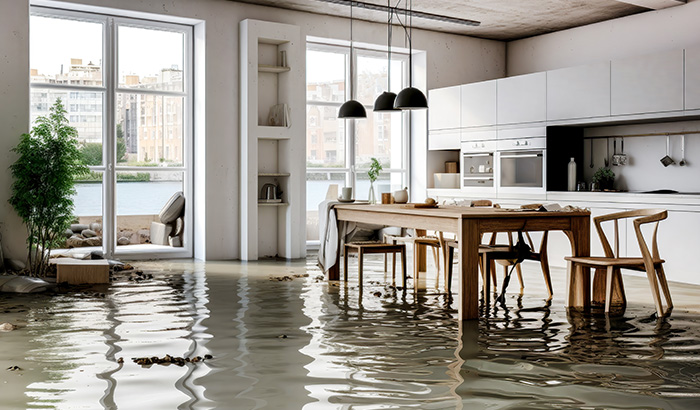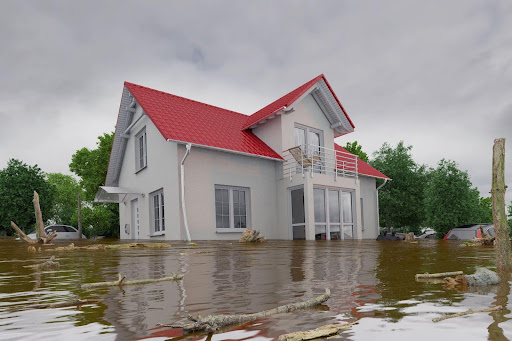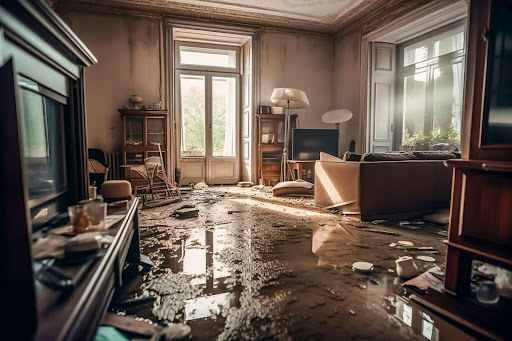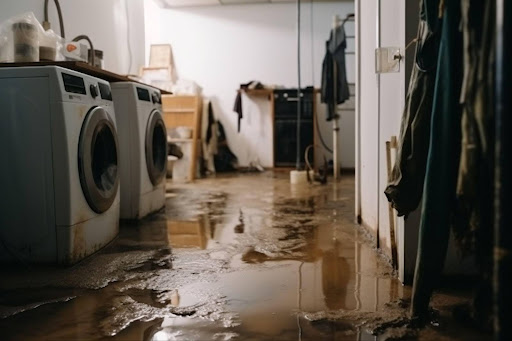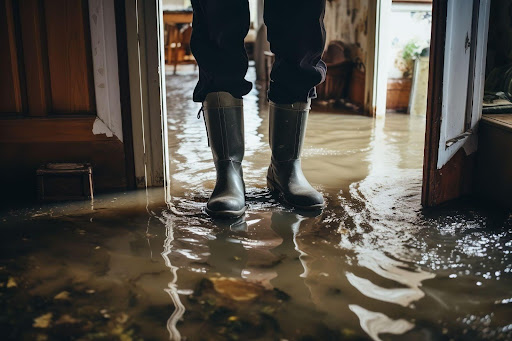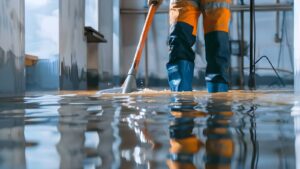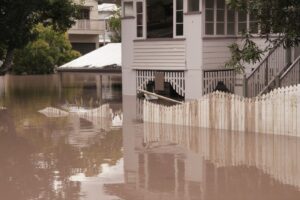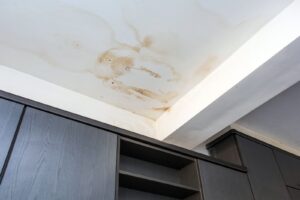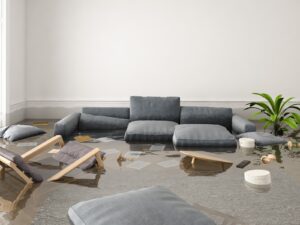Experiencing a flood in your home can be a distressing and disorienting event. The chaos and destruction it leaves in its wake can seem insurmountable. However, it is essential to recognize that swift and decisive action is key in effectively dealing with the aftermath of such an incident.
In this guide, we aim to support you through the essential steps that should be taken following a household flood. This guidance is applicable regardless of the flood’s cause, be it a ruptured pipe, an extreme weather event, or any other unforeseen circumstance. We aim to equip you with the necessary knowledge and strategies, from ensuring safety and well-being to dealing with insurance matters and embarking on the restoration journey.
In this article, we’ll cover critical safety measures, how to document damage for insurance purposes, and the steps involved in the clean-up and restoration process. With this information, you’ll be better prepared to tackle the challenges after a house flood.
1. Ensure everyone’s safety.
Safety should be your absolute priority when dealing with the aftermath of a house flood. In the wake of such an event, it’s imperative to take every necessary precaution to ensure everyone in your household remains safe and secure throughout the recovery process.
Here are some important safety considerations to keep in mind:
If you suspect any damage from flooding to utilities such as electricity, gas, or water lines, it’s crucial to turn them off. This can help prevent potential hazards, including electrical shocks, gas leaks, or further water damage. If you’re unsure about how to do this safely, it’s a good idea to seek professional guidance.
Then, the next priority should be to inspect your home for structural damage. Look for visible signs like sagging ceilings, leaning walls, or cracks in the foundation. Structural issues can pose a serious risk, so it’s essential to avoid entering affected areas until a professional can assess the damage.
Most importantly, floodwaters can carry various contaminants, including sewage, chemicals, and harmful bacteria. It’s vital to avoid direct contact with floodwater. If you must enter flooded areas, wear the appropriate protective gear, such as gloves and waterproof boots, to minimize exposure to potential health hazards.
By prioritizing safety and taking these precautions, you’ll create a safer environment for yourself and your family as you navigate the challenges of recovering from a house flood.
2. Document the damages.
When your home experiences a flood, documenting the damage is a crucial step in the recovery journey. Let’s delve into how you can effectively go about this important task.
Taking Photographs and Videos
Start by meticulously capturing clear and detailed pictures and videos of every area within your home that has fallen victim to the flood’s effects. Pay close attention to the condition of walls, floors, ceilings, and all your cherished belongings.
Record any visible water damage or telltale signs of flooding. These could include water stains, discolorations, or structural weaknesses.
You might wonder why this meticulous documentation is so crucial. These visual records become compelling evidence when you engage with your insurance provider to file a claim. They serve as irrefutable proof of the extent of the damage incurred, bolstering your case for insurance coverage.
Furthermore, as time progresses and the restoration efforts get underway, these initial records act as a reference point. They enable you to track the evolution of the damage, providing an invaluable resource for assessing the effectiveness of the restoration process.
Creating a Detailed Inventory of Damaged Items
Alongside your visual documentation, make a comprehensive list of all the items in your home that have suffered damage due to the flood.
For each item, note important details such as the brand, model, and approximate value. This inventory should encompass everything from furniture and appliances to electronics, clothing, and personal belongings. Having a detailed list will simplify the claims process with your insurance company and help you track what needs to be repaired or replaced.
Remember to store digital copies of your photos, videos, and inventory in a secure location, such as cloud storage or an external drive, to safeguard this critical information. By meticulously documenting the damage, you’ll streamline your path to recovery and ensure that your insurance provider has the necessary information to support you effectively.
3. Contact Your Insurance Provider.
One of your top priorities is to reach out to your insurance provider to initiate the claims process. This step can significantly ease the financial burden of the recovery process.
Initiating the Claims Process
Contact your insurance company as soon as possible after the flood occurs. Most insurance policies have specific timeframes within which you need to report the damage. If you don’t initiate a claim within that time frame, it might be more difficult to get insurance to cover the cost of the damages and restoration.
Be prepared to provide them with the necessary details, such as the date of the flood, the extent of the damage, and your contact information. Many insurance companies offer a dedicated hotline for claims, making it easier to get started promptly.
Providing Necessary Information and Documentation
Your insurer will require documentation to assess the damage accurately and process your claim. This documentation may include the photographs and videos you took during the initial assessment and your detailed inventory of damaged items.
The more comprehensive and well-organized your records, the smoother the claims process will be. It’s a good idea to keep copies of all communication with your insurance company for reference.
Understanding Your Insurance Coverage and Deductible
Take the time to review your insurance policy carefully. Understand what is covered and not, as flood coverage may require a separate policy from your standard homeowners or renters insurance.
Pay close attention to your policy’s deductible, which is the amount you’re responsible for paying before your insurance coverage kicks in. Knowing your coverage limits and deductibles will help you manage your expectations regarding the financial assistance you can expect from your insurance provider.
Remember that insurance processes can sometimes be complex, so don’t hesitate to ask questions and seek clarification from your insurance agent or adjuster if anything is unclear. Clear communication with your insurance company is key to a smooth and successful claims process, helping you get back on your feet faster after a house flood.
4. Begin the clean-up and restoration process.
After a house flood, the cleanup and restoration phase is a pivotal step in getting your home back to its pre-flood condition. It’s a comprehensive process that involves addressing various aspects to ensure your safety and the well-being of your property.
Mold Prevention and Remediation
Mold growth is a major concern following a house flood, and addressing it promptly is crucial to safeguard your health and your home’s structural integrity. Mold can flourish in the aftermath of a flood due to the excess moisture. Not only can mold cause health problems, but it can also inflict further damage to your property if left unchecked.
Swift action is essential to prevent mold from taking root. Begin by identifying and removing items that have sustained water damage beyond salvage. Make sure to dispose of the items properly. This step prevents mold growth on these items and creates a cleaner environment for remediation.
The next step is a thorough cleaning and disinfection process. Pay special attention to surfaces that were submerged during the flood.
Utilize appropriate cleaning agents to ensure that mold spores are eliminated effectively. Different surfaces may require different cleaning solutions. For hard, non-porous surfaces, such as countertops and tiles, disinfectants or a mixture of water and detergent can be effective. For porous materials like wood and fabric, consult a professional for suitable cleaning options.
Remember that mold can lurk not only on visible surfaces but also in hidden nooks and crannies.
Adequate ventilation is vital to preventing mold growth. Open as many windows and doors as possible to ensure your home is well-ventilated. Consider employing dehumidifiers to reduce moisture levels in the air. Lowering humidity inhibits mold’s ability to thrive, making your environment less hospitable for its growth.
In cases where you suspect extensive mold growth or are dealing with a severe mold infestation, it’s highly advisable to seek the assistance of professionals experienced in mold remediation.
These experts possess the knowledge, tools, and techniques to comprehensively assess and mitigate mold issues. They can also provide guidance on potential structural damage and necessary repairs.
Structural Repairs and Restoration
Assess the extent of structural damage caused by the flood. Depending on the severity, you may need to hire professionals to make necessary repairs. This can include fixing damaged walls, floors, electrical systems, plumbing, and more.
Floodwaters often carry contaminants that can jeopardize your health and the condition of your belongings. Determine which items can be salvaged and which should be discarded.
Porous items like mattresses and upholstered furniture may need to be replaced due to contamination, while non-porous items can often be cleaned and disinfected. Always follow safety guidelines and wear protective gear when handling contaminated materials.
Remember that the cleanup and restoration process can be complex and time-consuming. Seeking assistance from professionals experienced in flood damage restoration can significantly streamline the process and ensure a more successful outcome. Their knowledge and expertise are valuable assets in helping you restore your home and move forward after a house flood.
5. Prevent Future Flood Damage
As you navigate the aftermath of a house flood, consider how you can safeguard your home and family from future flood-related challenges. While predicting when the next flood might occur isn’t possible, you can certainly take proactive steps to minimize the risk and reduce potential damage.
Updating Your Emergency Plan and Kit
One of the key aspects of flood preparedness is keeping your emergency plan and kit up to date. Take some time to reflect on your recent experience with the flood. Evaluate the effectiveness of your emergency kit and ensure it contains fresh supplies. Keep an eye on expiration dates and replace any items that have passed their shelf life.
Your emergency kit should include essentials like non-perishable food, water, first-aid supplies, flashlights, batteries, a multi-tool, and any prescription medications that family members may need. Make sure you have at least a three-day supply for each person in your household.
Reviewing and practicing your evacuation routes and emergency communication strategies with your family is also crucial. This ensures that everyone is well-prepared and knows what to do in case of another flood.
Home Improvements to Mitigate Future Risks
Beyond preparing your family and emergency supplies, you should also focus on safeguarding your home against future floods. Here are some practical home improvements to consider:
Elevating Your Home
If your area is prone to flooding, elevating your home above potential flood levels can be a significant preventive measure. It’s advisable to consult with experts who specialize in home elevation to determine the appropriate height and method for your property.
Installing Flood-Resistant Barriers
Flood barriers like sandbags or flood shields for doors and windows can effectively divert water away from your home. However, ensuring they are correctly installed for maximum effectiveness is crucial.
Reinforcing Vulnerable Areas
Identify areas in your home particularly susceptible to water infiltration during a flood, such as basements or crawl spaces. Reinforce these areas by sealing cracks and, if necessary, installing sump pumps.
By taking these steps to enhance your flood preparedness and protect your home, you not only shield your property and belongings but also provide a sense of security for your family. Floods can be unpredictable, but with the right precautions, you can significantly reduce their impact on your life.
Total Flood and Fire Restoration
Total Flood and Fire Restoration is your dedicated ally in times of crisis. With our unwavering commitment to excellence and customer satisfaction, we bring experience and expertise to every restoration project.
Our professional team understands the unique challenges of flood damage and employs industry-leading techniques to ensure your home is restored to its pre-flood condition. We prioritize safety, structural integrity, and your peace of mind, providing comprehensive solutions that cover every aspect of flood restoration.
To safeguard your home, your family, and your peace of mind, contact Total Flood and Fire.

